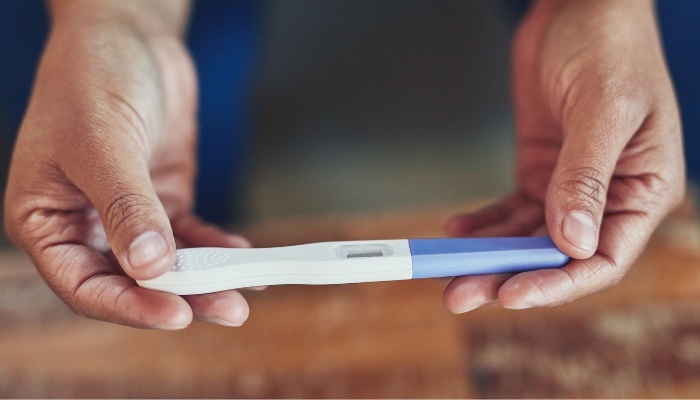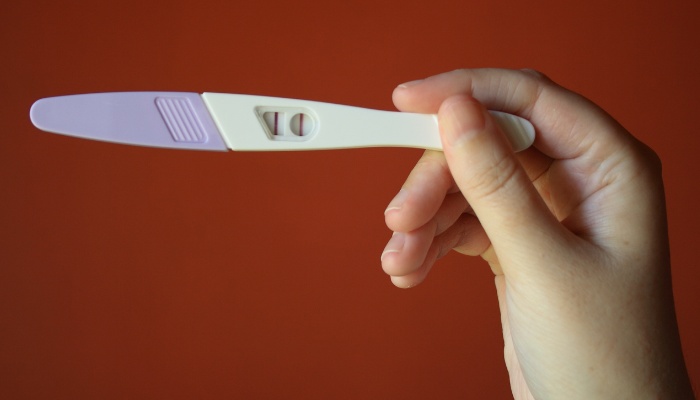If a home pregnancy test shows a test line that is darker than the control line, it indicates a high level of human chorionic gonadotropin (hCG). This is a clear indication of a positive pregnancy result.
A dark test line likely means that you are further along than you assumed, or it can be a sign of a multiple pregnancy.
However, Allo Health warns:
“An immediate dark positive pregnancy test does not necessarily indicate a healthy pregnancy. In some cases, it may be a sign of a molar pregnancy or an ectopic pregnancy, which require immediate medical attention.”
I experienced a very dark test line in the early stages of one of my pregnancies, so I understand the feelings that come with an unusual test result.
After consulting with an expert on the topic, I now understand that a dark test line is not really unusual and is typically a good sign!
Table of Contents
Pregnancy Test Lines
When reading a pregnancy test, it’s important to understand how the test functions, what causes the lines to appear, and what those lines mean.
How Home Pregnancy Tests Work
A home pregnancy test functions by identifying a hormone known as human chorionic gonadotropin (hCG) in a woman’s urine.
This hormone is produced by the placenta shortly after a fertilized egg attaches to the uterine lining, typically occurring around 6-12 days after fertilization.
When a woman uses the test, she urinates on the absorbent tip, which contains chemicals that interact with hCG.
Through capillary action, the urine is drawn along the test’s absorbent wick, carrying it to the testing area.
If hCG is present, it binds to specific antibodies in the testing area, forming a complex that moves along the test strip.
Upon encountering immobilized antibodies specific to hCG, a visible line (or lines) forms on the test, indicating a positive result.
The test also includes a control line that appears if the test functions correctly.
This line confirms that the urine has migrated properly and the chemicals are operating as intended.
Control Line
The control line is the first line that appears on a pregnancy test. It is typically darker and develops immediately upon soaking the tip in urine.
This line indicates that the test is working properly. When the control line is not present, the results of the test should be dismissed, and a new test should be taken.
Test Line
The test line is the second line that appears on a pregnancy test.
The test line is usually the fainter of the two and develops within a few minutes of soaking the tip in urine. When this line appears, no matter how faint, it means a positive result.
When the test line is not present, it means that either you are not pregnant or there is not enough hCG in your urine to determine pregnancy.
What a Positive Result Usually Looks Like
If the second line, otherwise known as the test line, shows up, it means that you are pregnant. It does not matter how faint the line is.
The only exception to this rule is when the control line is not visible or the test line is colorless.
Pregnancy Test: First Line Dark, Second Line Faint
A dark first line alongside a faint second line typically indicates pregnancy.
The second line is faint when there isn’t a high concentration of hCG in your urine. This can occur when you’re early on in your pregnancy.
Why Test Line May Be Darker Than Control Line
The transparency of the test line is determined by the level of hCG present in the urine.
Lower hCG amounts result in a faint line whereas higher quantities result in a darker line.
High levels of hCG can mean that you’re further along in your pregnancy than you may have anticipated. It can also be an indication of twins or multiples.
Immediate Dark Positive Pregnancy Test
If your test immediately yields a dark secondary line, it likely means that you’re further along than the standard week 4-8 window when most women find out.
You can call your doctor and request a dating ultrasound scan to get a more accurate measurement of how far along you are.
It could also mean that your hCG levels are higher due to pregnancy with multiples.
Allo Health shares: “It’s important to note that false positives can occur with immediate dark positive pregnancy tests.
This can happen if you have recently had a miscarriage or abortion, are taking certain medications, or have a medical condition that causes elevated hCG levels.”
Does Dark Line on Pregnancy Test Mean High HCG?
Yes, a dark line on a pregnancy test means that there is a high concentration of hCG in your urine.
HCG is a pregnancy hormone responsible for maintaining pregnancy in the early stages and peaks between 8 and 11 weeks.
Tests in which the result includes a dark test line and a faint control line are often referred to as “dye stealers.”
Does Test Line Darker Than Control Line Mean Twins?
If you’re pregnant with multiples, you will have higher hCG levels at each stage compared to singleton pregnancies.
That means that a home pregnancy test will pick up higher concentrations of hCG and produce a darker line.
Know that a darker line doesn’t always mean that there are multiple babies in utero.
Faint Line on Pregnancy Test Gets Darker After 10 Minutes
One of the most important things to remember with home pregnancy tests is that you have to use them according to the instructions to provide an accurate result.
This means checking your pregnancy test within the given time frame, which is usually around 10 minutes.
After this point, evaporation lines can appear from the urine sitting too long.
This faint line leads to the misinterpretation of a positive, also known as a false positive.
How To Take a Pregnancy Test Correctly

While taking a pregnancy test can seem intimidating, there are a few steps you can take to improve test accuracy:
- Wait until the morning to take a pregnancy test. This is when urine has the highest concentration of HCG.
- Read the instructions step by step. Read the instructions prior to doing the pregnancy test.
- Double-check your timing. Make sure to note the time needed to pee on the stick as well as when to interpret the results.
- Try the cup method. Pee into a small disposable cup, and soak the tip that way. This gives you better control of timing how long the tip is in urine and is less messy than your urine stream.
How To Avoid Common Mistakes
Here are the most common mistakes made when taking a home pregnancy test and how to avoid them:
- Don’t drink too much water. Doing so can dilute your urine, thereby diluting the HCG concentration within it.
- Don’t assume the timing. Not all pregnancy tests have the same testing window. Read the instructions carefully to know how long each step of the testing process takes.
- Don’t oversoak the stick. Oversoaking the stick can cause the test to malfunction. Make sure the plastic body of the test doesn’t touch the urine. The tip of the test is absorbent, so you don’t need to drown it.
- If you have a test on hand, make sure you check the expiration date. Most pregnancy tests are good for one or two years after purchase.
- Buy a test that fits your budget. There are two main styles of tests — digital and non-digital. Digital tests are more expensive and offer clearer results.
- Buy a test that fits your needs. If you are testing before or during your missed period, you may need to pick up an early detection test.
How Soon Will a Pregnancy Test Read Positive?
It’s important to read pregnancy test results in accordance with their directions. For most tests, you will have to wait a minimum of 3 minutes.
Depending on the concentration of HCG in your urine, your pregnancy test could read positive immediately or after just a few minutes.
Higher concentrations will show up faster than lower ones.
Some home pregnancy tests are marketed specifically for the speed of their results, like the First Response Rapid Result Pregnancy Test.
How To Read Pregnancy Test Results
For non-digital tests, the results are read as either one or two lines. One line indicates there is no pregnancy, whereas two lines indicate a positive pregnancy.
No matter how faint that second line is, its presence means that you are pregnant.
If the control line is absent, the test is not properly functioning, and a new one must be taken.
For digital tests, interpreting results is as easy as reading the words “Pregnant” or “Not Pregnant.”
The digital tests will inform you of a test malfunction via some sort of symbol correlating with the instructions.
Related Questions:
Is It Better To Dip or Pee on a Pregnancy Test?
It’s better to dip your pregnancy test in a cup of urine. This is more precise than running the stick under your urine stream.
Dipping the test offers control over the timing and submersion of the tip.
What Can Make a Pregnancy Test Less Accurate?
Several factors can affect the accuracy of your results, including:
- The time of your cycle when the test is taken
- The age of the test
- The time of day you take the test
- Whether the directions were followed precisely.
Charley is a mother of three with a passion for raising good humans. With her children in tow, she studies English and has made a career creating content about motherhood. In her free time, she enjoys traveling within the states to kayak, camp, and hike.

